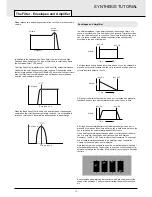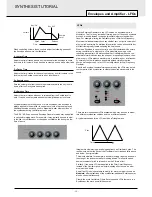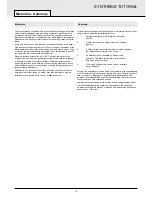
LFOs Section
There are two LFOs - Low Frequency Oscillators - available on the KS 4 /
KS 5. These produce regular electronic variations which are too low to be
heard when converted into audio vibrations. They can modify various ele-
ments of the sound, producing regular changes in pitch (vibrato), pulse
width or filter Cut off.
SPEED Knob
Controls the speed of the selected LFO. An LED directly below the knob
indicates the speed. Faster speeds are set by turning the knob clockwise.
These are suitable for vibrato and tremolo effects. Slower speeds are
more appropriate for Pulse Width changes or special effects.
WAVEFORM Knob
Selects the waveform shape for the selected LFO. As waveforms are
selected, the WAVEFORM LEDs update to reflect the currently selected
waveform and the screen displays the currently selected waveform type.
The first four LFO waveforms are the traditional types commonly found on
classic analogue synthesizers. Additional special waveform types (includ-
ing rythmic patterns) are also provided as detailed in the table below.
When one of these is selected, the MORE LED will be lit. Experiment !
Sine Wave
Gives the smoothest continuous change in level to the LFO. When routed
to pitch, it introduces vibrato or a siren effect dependent of its speed set-
ting. When routed to Filter Cut off, a Wow Wow effect results.
Triangle Wave
A
lso gives a smooth change in level to the LFO in a similar manner to the
Sine wave. As its name implies, the Triangle wave does not remain at the
peak of its waveform cycle for as long as the Sine wave. When routed to
pitch, it also introduces vibrato or a siren effect dependent of its speed
setting. When routed to Filter Cut off, a Wow Wow effect results.
Sawtooth Wave
G
enerates a rising level which then jumps back down to zero level.
Routed to the Filter Cut off, it produces a rhythmic pulse effect. Routing it
to pitch produces siren type sounds.
Square Wave
C
hanges level instantly from minimum to maximum. Useful for trills and
computer game effects. Very effective when used to modulate Osc Pitch.
Sample and Hold
At a regular interval (governed by the SPEED knob), the level of the LFO
jumps to a new random level and stays there until the next jump. This cre-
ates a rhythmic effect, particularly if routed to the Filter Cut off. Routing
this to pitch gives a less musical result, but is useful for computer / ran-
dom or machinery sound effects. A ‘quantized’ version is also available.
Here, the waveform is either at the top or bottom of its cycle. The effect is
similar to a square wave with an unpredictable pulse width setting.
Cross fade
A single -shot, linear decay from maximum to minimum level. This is use-
ful for implementing crossfades with an LFO used as a modfulator. With a
postive modulation amount, this LFO waveform ‘fades out’ the modulation.
With a negative modulation amount, this LFO waveform ‘fades in’ the
modulation.
Curved Sawtooth
Similar to a standard sawtooth wave, but the waveform slope is in fact an
exponentially decaying curve. When the LFO is used in ONE SHOT mode
as a simple Envelope Generator (see below), a Curved Sawtooth’s
‘decay’ often sounds more pleasing and natural than the straight, linear
‘decay’ of a standard Sawtooth wave.
Pattern trigger Waveforms
The last eight waveforms consist of rythmic trigger patterns. These are
especially effictive when the LFO is synchronised to the internal or exter-
nal MIDI clock. Experiment with the various patterns available to see
which ones work best for the Program.
DELAY Knob
Controls how long after the note is struck the selected LFO begins to take
effect. Fully anticlockwise and the selected LFO effect will begin immedi-
ately. Turning clockwise will cause the LFO effect to fade in. The time of
the fade in is dependent on the knob position. This is used for delayed
vibrato effects.
LFO Select Button
Selects which LFO the SPEED, WAVEFORM, DELAY and ONE SHOT
controls relate to. Select position 1 for LFO 1 and 2 for LFO 2.
ONE SHOT Button
This button makes an LFO play its waveform for only one cycle whenever
a keyboard note is played. An LED above the ONE SHOT button indi-
cates when the currently selected LFO is in One Shot mode.
Normally, the LFOs cycle through their waveform cycles continuously.
Setting an LFO to operate in One Shot mode when it has its SPEED
parameter set to a fairly slow value allows an LFO to be used (in effect)
as a fairly simple Envelope generator. In this case, the SPEED knob con-
trols the duration of any ‘Attack’ and / or ‘Decay’ phases in the ‘Envelope’.
Reversing the polarity of the amount of LFO modulation applied (for
example, from -20 to +20) has the effect of mirroring the LFO waveform
about the horizontal axis so that the ‘Attack’ phase becomes the ‘Decay’
phase and vice versa.
MAIN FEATURES AND OPERATION
LFOs Section
•
25
•
LFO Waveforms
No.
Description
0
Sine
1
Tri-Angle
2
Sawtooth
3
Square
4
Sample & Hold
5
Sample & Hold Quantized
6
Cross Fade
7
Fast Attack - Medium Decay Expo Ramp
8
Fast Attack - Fast Decay Expo Ramp
9
Fast Attack - Very Fast Decay Expo Ramp
10
Medium Attack - Fast Decay Expo Ramp
11
Slow Attack - Fast Decay Expo Ramp
12
Very Slow Attack - Fast Decay Expo Ramp
13
Fast Attack - Medium Hold - Medium Decay Ramp
14
Fast Attack - Long Hold - Medium Decay Ramp
15
Fast Attack - Longer Hold - Medium Decay Ramp
16
Attack - Fast Decay - Second Decay Ramp
17
Attack - Medium Decay - Second Decay Ramp
18
Attack - long Decay - Second Decay Ramp
19
Blipper
20
Chromatic Up Ramp ( Set Osc LFO amount to 30)
21
Major Chord Ascending
22
Major 7th Chord Ascending
23
Minor 7th Chord Ascending
Rhythm Paterns
24
Pattern 1
25
Pattern 2
26
Pattern 3
27
Pattern 4
28
Pattern 5
29
Pattern 6
30
Pattern 7
31
Pattern 8
















































